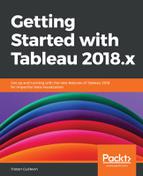When you create an Extract, Tableau copies your database into a Hyper file (since Tableau 10.5) on your computer. Then, the Data Source is no longer linked to the database but to the Hyper file.
The first advantage of the Extract is that it's optimized for Tableau, meaning that no matter the speed of your initial connection, you will have excellent performance. Keep that in mind. If you think that your Dashboard is slow, the first thing to check is whether you are using an Extract. You are also able to work offline because the Extract is a local copy of your database.
Unlike a Live connection, you don't observe instantly the changes in the database. To see the changes, you need to refresh the Extract. When you update it, Tableau connects again to the database and creates a new copy of the data into the Hyper file.
The only problem you may encounter is when you try to create an Extract from a huge database. As Tableau needs to copy the data, it could take a long time to retrieve all the rows. To deal with that, you can click on Edit, next to the Extract option, add some Filters, and aggregate the data or indicate the number of rows to retrieve. Usually, you don't need to do that, but keep in mind that it exists.
You can see in the following screenshot the options when editing an Extract:

Since Tableau 2018.3, you can specify the schema used for the extract. If you create a data source combining Multiple Tables, it could be better to use the Multiple Tables schema for better performance. This topic is covered in detail the Chapter 1, Catch up with Tableau 2018.
There are pros and cons of using either the Live or Extract Data Source. In the end, the choice is yours, but now you can make the best decision.
